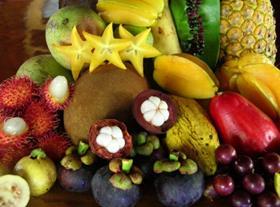
The exotics market is experiencing something of a boom, with strong value and volume sales defying general market deflation.
Figures from Kantar Worldpanel show the exotics category to have taken a step closer to the £500 million mark after 8.4 per cent growth took market value to £471m [52 w/e 29 March]. Increased purchase frequency and new shoppers also helped drive a 3.7 per cent volume uplift.
“We’ve seen an increase in demand for exotics across the board from retail and processing,” says Terry Watts, managing director of Vidafresh. “It’s an ongoing situation as far as we’re concerned, and we’ve picked up quite a bit of business in the past year with new and existing clients. We are definitely seeing an increase in demand in so far as they have asked for extra volume over and above what’s programmed.”
Mark Stuart, head of sales and marketing at Jacana Produce, believes the momentum behind the healthy living movement is having a positive effect on the sector. “The exotics category continues to grow, especially so with the current health, fitness and wellbeing boom that we are seeing across social media,” he says. “The health benefits and antioxidant properties of some of these products are substantial and as consumers become more aware of these benefits we should continue to see increased demand.”
Tropifresh owner Peter Durber agrees, stressing that sales are also being boosted by exotics moving firmly into the mainstream, with the clientele no longer simply first and second generation migrants, but also people who have travelled the world and are interested in trying new products.
Taking sweet potatoes as an example, Durber says the volumes coming from outside the mainstream powerhouses of North America and Israel are on the rise, with product now arriving from niche markets such as Uganda, Honduras, Brazil and Jamaica, and purple sweet potatoes from the Far East.
Supply of another niche line, jelly coconuts, has failed to live with demand on the back of the explosion in popularity of coconut water, says Durber. Formosa papayas are also gaining traction.
On the more mainstream lines, the mild winter helped sales of melons and pineapples, according to Watts, although a cold March and April is likely to have stunted early spring sales. “What also helped is that we had consistently good quality melons throughout the winter trading period, and the fact that they are value for money in the retailer compared to other products.”
While that is all positive, it comes with the caveat that the market is becoming more difficult due to the increased number of players. “I would say that because of how competitive it’s become you have to be absolutely on the button,” says Durber.
“Historically the exotics market was quite small and niche, but that has all changed. There’s more risk and less upside as a supplier but that’s not to say that it’s not still a reasonable living.”
Another major exotics supplier, who did not want to be named, backed Durber’s view, describing the market as “fiercely competitive”. “There are lots of importers fighting for business, and you’ve got specialists such as Scott Farms on sweet potatoes coming in and doing an excellent job, and other one-man bands focusing on a single product. But that’s making it more difficult for the rest.
“Consistency of supply is absolutely critical, and of course profitability is affected, particularly on semi-exotic lines such as asparagus, green beans, sweet potatoes and so on.”
Inevitably in such a diverse category served by so many supply nations across the world, small exporters can speculate on the category, creating a degree of boom and bust, according to the source. The growing popularity of exotic fruit and veg means that situation is not likely to go away anytime soon.
Another challenge still facing the exotics category is how to increase penetration among lower-income groups, with the products still being regarded as a luxury in some quarters. Exotics overindex among shoppers in the ABC1 social classes, as well as among older consumers.
There is at least good progress being made in widening exotics’ appeal thanks to ready-to-eat products such as mango and avocado, Stuart points out, adding that consumer education is key to building understanding of seasonality, storage and usage.



